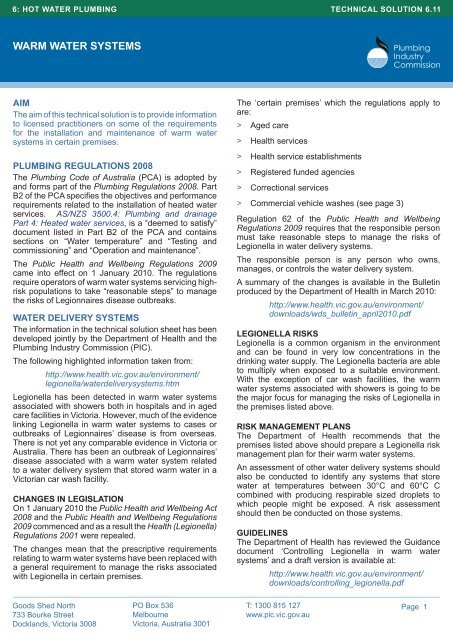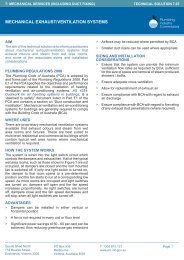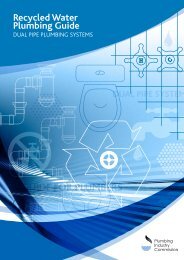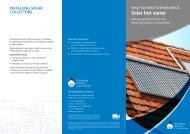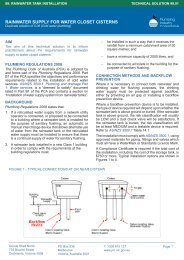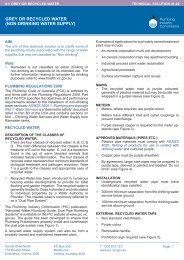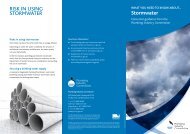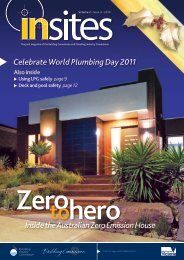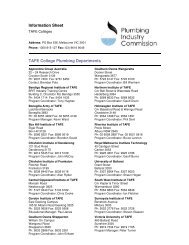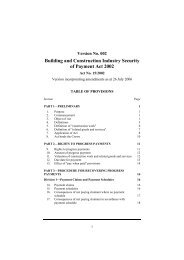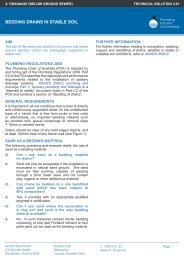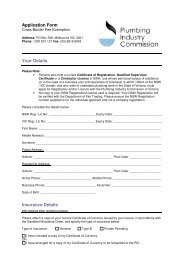6.11 Warm water systems (3.4MB) - Plumbing Industry Commission
6.11 Warm water systems (3.4MB) - Plumbing Industry Commission
6.11 Warm water systems (3.4MB) - Plumbing Industry Commission
You also want an ePaper? Increase the reach of your titles
YUMPU automatically turns print PDFs into web optimized ePapers that Google loves.
6: HOT WATER PLUMBING TECHNICAL SOLUTION <strong>6.11</strong><br />
WARM WATER SYSTEMS<br />
AIM<br />
The aim of this technical solution is to provide information<br />
to licensed practitioners on some of the requirements<br />
for the installation and maintenance of warm <strong>water</strong><br />
<strong>systems</strong> in certain premises.<br />
PLUMBING REGULATIONS 2008<br />
The <strong>Plumbing</strong> Code of Australia (PCA) is adopted by<br />
and forms part of the <strong>Plumbing</strong> Regulations 2008. Part<br />
B2 of the PCA specifies the objectives and performance<br />
requirements related to the installation of heated <strong>water</strong><br />
services. AS/NZS 3500.4: <strong>Plumbing</strong> and drainage<br />
Part 4: Heated <strong>water</strong> services, is a “deemed to satisfy”<br />
document listed in Part B2 of the PCA and contains<br />
sections on “Water temperature” and “Testing and<br />
commissioning” and “Operation and maintenance”.<br />
The Public Health and Wellbeing Regulations 2009<br />
came into effect on 1 January 2010. The regulations<br />
require operators of warm <strong>water</strong> <strong>systems</strong> servicing highrisk<br />
populations to take “reasonable steps” to manage<br />
the risks of Legionnaires disease outbreaks.<br />
WATER DELIVERY SYSTEMS<br />
The information in the technical solution sheet has been<br />
developed jointly by the Department of Health and the<br />
<strong>Plumbing</strong> <strong>Industry</strong> <strong>Commission</strong> (PIC).<br />
The following highlighted information taken from:<br />
http://www.health.vic.gov.au/environment/<br />
legionella/<strong>water</strong>delivery<strong>systems</strong>.htm<br />
Legionella has been detected in warm <strong>water</strong> <strong>systems</strong><br />
associated with showers both in hospitals and in aged<br />
care facilities in Victoria. However, much of the evidence<br />
linking Legionella in warm <strong>water</strong> <strong>systems</strong> to cases or<br />
outbreaks of Legionnaires’ disease is from overseas.<br />
There is not yet any comparable evidence in Victoria or<br />
Australia. There has been an outbreak of Legionnaires’<br />
disease associated with a warm <strong>water</strong> system related<br />
to a <strong>water</strong> delivery system that stored warm <strong>water</strong> in a<br />
Victorian car wash facility.<br />
CHANGES IN LEGISLATION<br />
On 1 January 2010 the Public Health and Wellbeing Act<br />
2008 and the Public Health and Wellbeing Regulations<br />
2009 commenced and as a result the Health (Legionella)<br />
Regulations 2001 were repealed.<br />
The changes mean that the prescriptive requirements<br />
relating to warm <strong>water</strong> <strong>systems</strong> have been replaced with<br />
a general requirement to manage the risks associated<br />
with Legionella in certain premises.<br />
Goods Shed North<br />
733 Bourke Street<br />
Docklands, Victoria 3008<br />
PO Box 536<br />
Melbourne<br />
Victoria, Australia 3001<br />
The ‘certain premises’ which the regulations apply to<br />
are:<br />
> Aged care<br />
> Health services<br />
> Health service establishments<br />
> Registered funded agencies<br />
> Correctional services<br />
> Commercial vehicle washes (see page 3)<br />
Regulation 62 of the Public Health and Wellbeing<br />
Regulations 2009 requires that the responsible person<br />
must take reasonable steps to manage the risks of<br />
Legionella in <strong>water</strong> delivery <strong>systems</strong>.<br />
The responsible person is any person who owns,<br />
manages, or controls the <strong>water</strong> delivery system.<br />
A summary of the changes is available in the Bulletin<br />
produced by the Department of Health in March 2010:<br />
http://www.health.vic.gov.au/environment/<br />
downloads/wds_bulletin_april2010.pdf<br />
LEGIONELLA RISKS<br />
Legionella is a common organism in the environment<br />
and can be found in very low concentrations in the<br />
drinking <strong>water</strong> supply. The Legionella bacteria are able<br />
to multiply when exposed to a suitable environment.<br />
With the exception of car wash facilities, the warm<br />
<strong>water</strong> <strong>systems</strong> associated with showers is going to be<br />
the major focus for managing the risks of Legionella in<br />
the premises listed above.<br />
RISK MANAGEMENT PLANS<br />
The Department of Health recommends that the<br />
premises listed above should prepare a Legionella risk<br />
management plan for their warm <strong>water</strong> <strong>systems</strong>.<br />
An assessment of other <strong>water</strong> delivery <strong>systems</strong> should<br />
also be conducted to identify any <strong>systems</strong> that store<br />
<strong>water</strong> at temperatures between 30°C and 60°C C<br />
combined with producing respirable sized droplets to<br />
which people might be exposed. A risk assessment<br />
should then be conducted on those <strong>systems</strong>.<br />
GUIDELINES<br />
The Department of Health has reviewed the Guidance<br />
document ‘Controlling Legionella in warm <strong>water</strong><br />
<strong>systems</strong>’ and a draft version is available at:<br />
http://www.health.vic.gov.au/environment/<br />
downloads/controlling_legionella.pdf<br />
T: 1300 815 127<br />
www.pic.vic.gov.au<br />
Page 1
6: HOT WATER PLUMBING TECHNICAL SOLUTION <strong>6.11</strong><br />
WARM WATER SYSTEMS<br />
The guide provides a graduated approach to assessment<br />
and review:<br />
1. Undertake a site audit to locate, gather and<br />
document basic information about each warm <strong>water</strong><br />
system.<br />
2. Complete the template for basic assessment and<br />
review, documenting methods for addressing any<br />
identified issues or risks.<br />
3. Keep accurate and detailed records of all<br />
maintenance work.<br />
4. Develop a <strong>water</strong> sampling strategy and commence<br />
regular sampling for Legionella.<br />
5. Develop a clear plan on what to do should Legionella<br />
be detected in a system.<br />
Additional steps are recommended where more<br />
advanced assessment and management are indicated:<br />
6. Complete the template for advanced assessment<br />
and management, documenting how any issues<br />
and risks identified will be addressed.<br />
7. Develop a plan for management of the warm <strong>water</strong><br />
system.<br />
CAR WASHES<br />
The Public Health and Wellbeing Act 2008 and the Public<br />
Health and Wellbeing Regulations 2009 commenced on<br />
1 January 2010. Because a car wash facility was linked<br />
to 7 cases of Legionnaires’ disease in 2008, these car<br />
wash facilities have been included in the list of certain<br />
premises that must control the risk of Legionella.<br />
Regulation 62 requires that the responsible person must<br />
take reasonable steps to manage the risks of Legionella<br />
in the delivery system located at the premises.<br />
The responsible person is any person who owns,<br />
manages, or controls the <strong>water</strong> delivery system.<br />
The Act and regulations are available at:<br />
http://www.legislation.vic.gov.au/<br />
What are the risks for a car wash facility?<br />
Risk factors for Legionella growth in car washes are:<br />
> <strong>Warm</strong> <strong>water</strong> stored at temperatures between 30°C<br />
and 60°C<br />
> Rubber hosing<br />
> Absence of a biocide ( a chemical agent capable of<br />
destroying living organisms).<br />
Goods Shed North<br />
733 Bourke Street<br />
Docklands, Victoria 3008<br />
PO Box 536<br />
Melbourne<br />
Victoria, Australia 3001<br />
People may contract Legionnaires’ disease if they are<br />
exposed to small droplets containing the bacteria, like<br />
those produced by high pressure spray hoses.<br />
The Department of Health recommends that all car wash<br />
facilities assess the risks associated with their <strong>systems</strong><br />
and prepare a Legionella risk management plan.<br />
To manage the risks associated with Legionella, the<br />
following should be considered:<br />
> Not using stored warm <strong>water</strong> at temperatures<br />
between 30°C and 60°C<br />
> Replacing warm <strong>water</strong> storage with instantaneous<br />
units<br />
> Replacing rubber hosing with poly tubing, metal<br />
tubing or clean copper tubing<br />
> Regularly disinfecting the system with a chlorine<br />
based disinfectant.<br />
For more details on managing the risks of Legionella<br />
in warm <strong>water</strong> <strong>systems</strong>, down load a copy of the draft<br />
version Controlling Legionella in warm <strong>water</strong> <strong>systems</strong><br />
2010, available at:<br />
http://www.health.vic.gov.au/environment/<br />
downloads/controlling_legionella.pdf<br />
You can also obtain further information from the<br />
Australian Car Wash Association at:<br />
http://www.acwa.net.au/<br />
WATER TEMPERATURE GUIDELINES<br />
The following Figures (1-7) provide a guide to different<br />
types of warm <strong>water</strong> <strong>systems</strong> (other than car washes).<br />
T: 1300 815 127<br />
www.pic.vic.gov.au<br />
Page 2
6: HOT WATER PLUMBING TECHNICAL SOLUTION <strong>6.11</strong><br />
WARM WATER SYSTEMS<br />
FIGURE 1 - CLASSIFICATIONS OF WATER TEMPERATURES<br />
FIGURE 2 - STORAGE WARM WATER SYSTEM<br />
Goods Shed North<br />
733 Bourke Street<br />
Docklands, Victoria 3008<br />
PO Box 536<br />
Melbourne<br />
Victoria, Australia 3001<br />
T: 1300 815 127<br />
www.pic.vic.gov.au<br />
Page 3
6: HOT WATER PLUMBING TECHNICAL SOLUTION <strong>6.11</strong><br />
WARM WATER SYSTEMS<br />
FIGURE 3 - MULTIPLE STORAGE WARM WATER SYSTEMS<br />
FIGURE 4 - WARM WATER SYSTEM<br />
Goods Shed North<br />
733 Bourke Street<br />
Docklands, Victoria 3008<br />
PO Box 536<br />
Melbourne<br />
Victoria, Australia 3001<br />
T: 1300 815 127<br />
www.pic.vic.gov.au<br />
Page 4
6: HOT WATER PLUMBING TECHNICAL SOLUTION <strong>6.11</strong><br />
WARM WATER SYSTEMS<br />
FIGURE 5 - WARM WATER INDIRECT SYSTEM<br />
FIGURE 6 - WARM WATER CONTINUOUS FLOW SYSTEM<br />
Goods Shed North<br />
733 Bourke Street<br />
Docklands, Victoria 3008<br />
PO Box 536<br />
Melbourne<br />
Victoria, Australia 3001<br />
T: 1300 815 127<br />
www.pic.vic.gov.au<br />
Page 5
6: HOT WATER PLUMBING TECHNICAL SOLUTION <strong>6.11</strong><br />
WARM WATER SYSTEMS<br />
FIGURE 7 - MULTIPLE CONTINUOUS FLOW WARM WATER SYSTEM ELECTRONICALLY CONTROLLED<br />
TEMPERATURE HEATING SYSTEM<br />
MAINTENANCE REQUIREMENTS FOR<br />
THERMOSTATIC MIXING VALVES<br />
It is a requirement of AS/NZS 3500.4 that thermostatic<br />
mixing valves “be inspected periodically to ensure proper<br />
operation”. The PIC recommends that thermostatic<br />
mixing valves be inspected and serviced annually in<br />
accordance with AS 4032.3 Water supply-valves for<br />
the control of heated <strong>water</strong> supply temperatures Part<br />
3: Requirements for field-testing, maintenance or<br />
replacement of thermostatic mixing valves, tempering<br />
valves and end-of-line temperature control devices.<br />
REFERENCES<br />
• Public Health and Wellbeing Act 2008<br />
• Public Health and Wellbeing Regulations 2009<br />
• Building (Legionella Risk Management)<br />
Regulations 2001<br />
• Building Regulations 2006<br />
Goods Shed North<br />
733 Bourke Street<br />
Docklands, Victoria 3008<br />
PO Box 536<br />
Melbourne<br />
Victoria, Australia 3001<br />
For further information refer to:<br />
http://www.health.vic.gov.au/environment/<br />
legionella/<strong>water</strong>delivery<strong>systems</strong>.htm<br />
T: 1300 815 127<br />
www.pic.vic.gov.au<br />
Page 6


